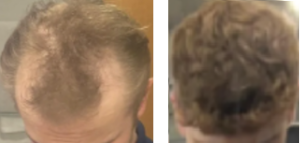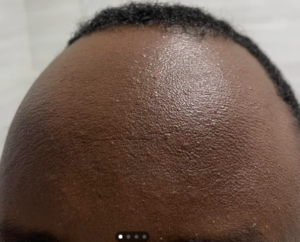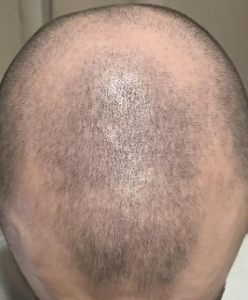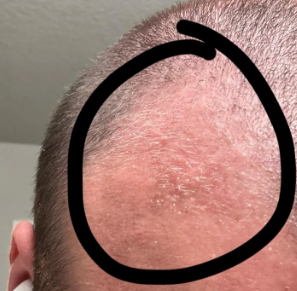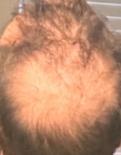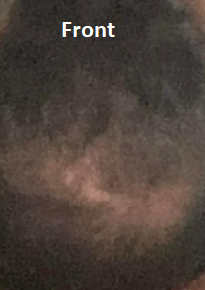I just started with a Dr Pen on my widows peak. 0.6mm, speed of 3. I made small circular/swirling movements. The skin got a little red, but not much, and no little bleeding pricks. This morning (did it 9 hours ago) the area feels like I have a slight sunburn. I didn’t spend long, only a couple minutes, doing the whole area but relatively it isnt a huge area.
Should I be seeing more reaction? I took a picture but it didn’t even look like anything, though in person the area was a bit redder.
The epidermis is 0.5mm thick, and there are no stem cells in it. The stem cells you want to reach are 1.0-1.5mm below the epidermis. It would be best if you went deeper. I generally tell my patients to use a depth of 1.25, and rather than a circular motion, hold it in each place for 10 seconds.
I saw so many pictures of people getting back most of what they lost, even though at first you would think he’ll be bald forever. So i’m curious what happens to the hair follicles? Do they really die, or are they all dormant? Thanks
Great question! Normal hair goes through cycles, and one of the parts of a complete cycle is catagen, when the hair follicles are almost entirely gone, and then miraculously wake up and start growing again. Then there are the hairs that are being lost, some first through miniaturization, and others just fall out and don’t come back. The miniaturized hairs will eventually go that route, fall out, and not return. If left alone, many of these hairs will not return; however, if we kick them with drugs like minoxidil or finasteride, especially in young men, sometimes these hairs will restart and get going again. Then there are those men who have done nothing about their hair loss for a decade or longer. They are in their 30s or 40s, and most do not respond to drugs like minoxidil or finasteride if they start them 10+ years after they lose their hair. A few of these men might respond to minoxidil alone, usually not finasteride. Then there is another group of men who add microneedling, have had complete hair loss for more than 10 years, and miraculously, the hair starts growing again. This suggests that the stem cells are still there, sitting around as if G-d intended them to wait for another kick, and that kick seems to be microneedling. So, to answer your question, it does seem like the genuinely bald man, let’s say, with a Class 7 pattern of hair loss, still can grow his hair regardless of the balding pattern and the length of time the balding has been there. With that said, I don’t know if this reasoning extends to a 65-year-old male who has had a Class 7 balding pattern since age 26. I haven’t seen any man like this start microneedling and kickstart his hair again, even using minoxidil and finasteride simultaneously.
The good news is that someone will find a drug, sooner or later, that will likely kick-start the hairs in all balding men who are lying dormant. That is what we are waiting for.
Been looking everywhere but don’t know what to trust, especially for my situation. I got my hair loss from my Mom’s father. Money is tight so I don’t know what I can even do. Don’t know anything about hair (or really any kind of self maintenance.) Until November last I had (bad) long hair that went down my back but it wasn’t as thin as it is now. My mom is very sick and I’m up to my neck in stress over everything right now.
Crown loss usually responds to oral finasteride, which costs $30/year at Costco. Stress accelerates hair loss, but finasteride can help it stabilize or even reverse at your age.
This man appears to be developing a Class 3 A pattern of balding. I would have to look closely at what is going on down the middle of his head, but I suspect he is thinning, possibly in a Class 5 A pattern, which is where the 3 A pattern goes as it develops. I would have to examine him to know what is going on, as it could be other conditions, other than genetic hair loss.
I’ve been considering options for addressing my large forehead. It has made me incredibly insecure for a long time. I’m unsure whether a hair transplant or a forehead reduction surgery would be more suitable for me in terms of lowering my hairline and achieving a natural look. Any advice or suggestion would be appreciated.
You have male pattern balding with significant frontal recession. This recession will advance with time unless you get your hair loss under control with good medications. A hairline advancement surgery should never be done when there is a likelihood that further recession will occur (which is you). In addition, the leading edge of what hairline you have, is not wide enough to create a gook looking advanced hairline. Assuming that you already tried to treat the hair loss with proper medications and it failed, then you might be a candidate for a hair transplant, but you would have to be evaluated by a good, competent doctor.
Prior to knowing what is the number of grafts I would do, I would have to know 1) what is your donor density and the health of your donor area by trichoscopy, 2) what is your hair thickness of hairs in the donor area (fine, medium or coarse measures 30, 50, 70+ microns in thickness respectively). The thicker the hair, the less the grafts needed. Your hair loss pattern is unusual, but that entire central area runs the risk of loss unless you take some drug like finasteride to hold on to that hair. Before you jump into a hair transplant, I hope you share you age with me.
Is it normal for baby hairs to not have color? Been on min for about 2 months. Just started fin. Decided to buzz my hair while it thickens up and noticed all these new hairs.
You are looking at Vellus hairs that probably will not turn into scalp hairs with color. The normal groupings of ‘terminal’ scalp hairs, all of these little vellus hairs in varying numbers, grow in the groupings. I don’t believe that these ever grow into terminal scalp hairs. They are always colorless.
OK so I’ve done some researching and found articles stating that hair training aka infrequent washing can lead to hairloss or accelerate it. I believe it’s because of buildup of sebum on the scalp? I’m not too sure on how that works. This scares me because I hardly shampoo, mainly using conditioner to wash or just water to clean my hair but I at least try to shampoo once or twice a month. My hair when I shampoo feels very poopy and looks very unhealthy compared to when I don’t shampoo. But if it accelerates hairloss like some articles claim I’ll be more then glad to start shampooing more.
Many of my patients tell me that they see homeless men with full heads of hair who probably never wash or shampoo. That is true, so shampooing is not necessary. When vigorously performed, frequent shampooing may pull out the miniaturized hairs that are about to fall out. Aggressive brushing after shampooing will pull out miniaturized hairs relatively easily.
From my practice perspective, it runs about 2-4% consistent with what Merck reported; however, on Forums like Reddit, where many young men talk up side effects, it is far more common. I believe that this shows that men can easily talk themselves into the sexual side effects. I often, when joking, tell my young patients before they start finasteride, that if I told them “by breathing the hair in my office, you won’t get an erection tonight“, they smile but get the message of just how powerful such messages are.
I started topical Finasteride 5 months ago (fin/min 0.15%/7%), and after 5 weeks I started to shed HEAVILY so it’s been almost 4 months of continuous shed. I don’t know what to do. I have been applying Minoxidil for almost 10 years and the initial shed was never as bad as this. Most of the sheds last 1 or 2 months I’m reading. I don’t know if I will be losing everything, or if i should try a higher topical dose (I also tried 0.25% topical before for 3 months), oral fin and then at what dose?
Topical finasteride goes systemic, but the amount is not in your control. If you use the oral, then you have better control. The hair loss response to the finasteride tells you that it is working, so be patient.
Im 20 and I been balding since I was 16, I’m on fin and min but I know eventually I will lose it all so I was thinking I’ll probably need more than one transplant in the future. But I was wondering, is it possible to cover your whole scalp with implants assuming I go completely bald in a few years?
I expect that my answer to your question is purely academic. Before you take the hair transplant route, you must qualify with regard to Age (at least 25 years old) and have good health of your scalp and donor area. I expect that you will have male pattern balding. With a healthy donor area, I am assuming that you are an average man with a donor density of 2.2 hairs/mm/square. Based on your question asking ‘What is the maximum amount of hair that can be transplanted?’, I would assume (academically) that your balding would eventually become a Class 7 pattern of balding.
As described above, the donor area in such a person has about 7000-9000 grafts that can be transplanted. That is enough to get good coverage for the most advanced balding pattern. Please consider adding Scalp Micropigmentation to the treatment plan to maximize the fullness. I have followed one patient for over 20 years as he evolved into a Class 7 pattern of balding. He had many surgeries as his balding evolved. This man was very detail-oriented and had to maintain his hairy appearance throughout the balding process without any evidence that he had a hair transplant. He started these surgeries before FUE or SMP was available and was fortunate that his donor supply was higher than an average man’s donor supply. We finished his entire treatment using FUE and SMP to fine-tune his final result. You can see his final result after receiving 11,000 grafts and SMP here: https://baldingblog.com/norwood-class-7-pattern-patient-received-11000-grafts-plus-smp/
I believe that men who use the Dr. Pen device with 36 needles and a depth of 1.25mm have the best chance to reverse their hair loss. The idea is to control the damage to the area where the stem cells reside that may trigger hair growth. I advise my patients to hold this reciprocating pen in a single spot for 10 seconds, then move it to the next spot where they want the hair to grow. Let’s say that you have an area of 2 by 3 inches; that means that the pen is held in many positions until the entire targeted area has been covered by the pen. This injury starts off a healing cascade with some bleeding, platelet aggregation, and the appearance of special defense cells called macrophages. Special proteins that stimulate new blood vessel formation pour into the wound and are followed by stem cell activation, which often triggers hair follicle growth. When this process is repeated weekly with a Dr. Pen device, I believe you get the best control of the healing cascade.
Page 6 of 634

